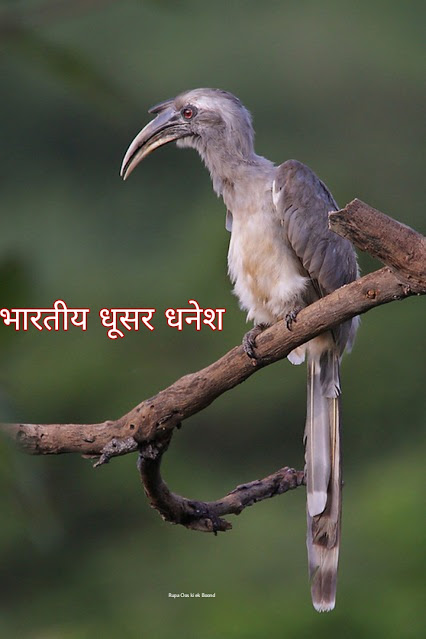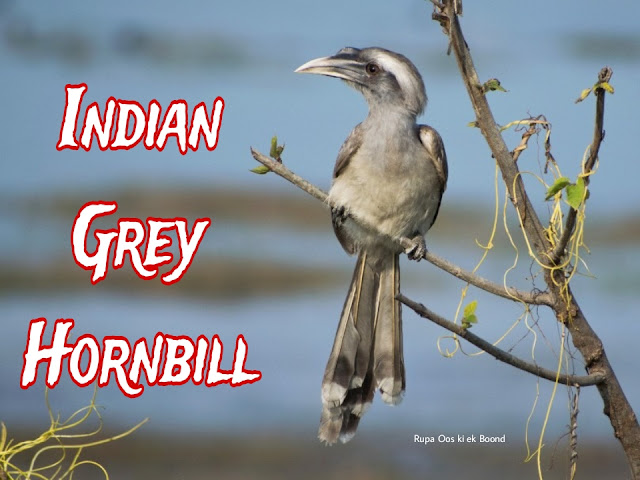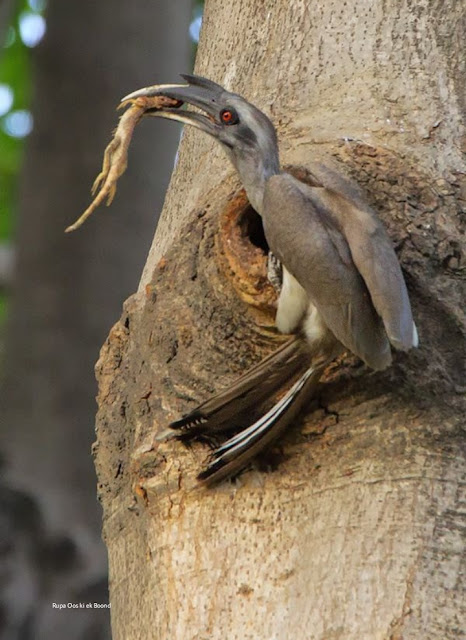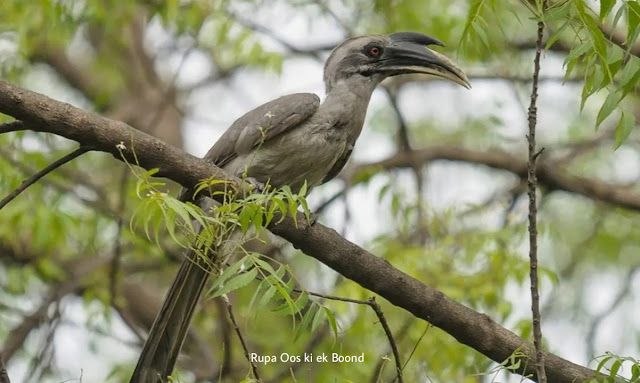चंडीगढ़ का राज्य पक्षी (State Bird of Chandigarh)
जब भी पक्षियों के बारे में लिखती हूं, तो सोचती हूं काश मेरे पास भी पंख होते और मैं भी इन पक्षियों की तरह स्वच्छंद आसमान में उड़ान भरती। खैर यह कल्पना की उड़ान है कहीं तक भी जाती है। आज चर्चा करते हैं, चंडीगढ़ के राजकीय पक्षी के बारे में, जिसका नाम है "भारतीय धूसर धनेश (Indian Grey Hornbill)"।
इसका वैज्ञानिक नाम Ocyceros birostris (ऑकीसेरॉस बिरोस्ट्रिस) है। यह सर्वाधिक वानस्पतिक पक्षी है और आमतौर पर जोड़े में दिखायी पड़ती है। इनमे पूरे शरीर पर ग्रे रंग के रोयें होते हैं और इनके पेट का हिस्से हल्का ग्रे या फीके सफ़ेद रंग का होता है। इनके सिर का उभार काले या गहरे ग्रे रंग का होता है। यह लगभग 24 इंच लम्बी होती है। इनके शरीर का ऊपरी हिस्सा मिश्रित ग्रे और भूरे रंग का होता है और फीके पीले रंग की आंख की भौहों के भी कुछ हल्के निशान देखे जा सकते हैं। कान का आवृत भाग गहरे रंग का होता है। पंख के उड़ान भरने वाले पर गहरे भूरे रंग के होते हैं और इनका सिरा सफ़ेद रंग का होता है। इनकी पूंछ का अग्रसिरा सफ़ेद होता है और गहरे रंग की उपांत धारी होती है। इनकी आंख की पुतली लाल रंग की होती है और पलक पर बाल होते हैं।
इस पक्षी की नर और मादा प्रजातियों के बीच कुछ बुनियादी अंतर पाए जाते हैं:-
नर के पास एक गहरे रंग की चोंच पर एक बड़ा आवरण होता है और एक पीले रंग का कलमेन होता है और निचला जबड़ा कम होता है। वयस्क नर में आंखों के आसपास की नग्न त्वचा गहरे रंग की होती है, जबकिमादाओं में यह हल्के लाल रंग की होती है। मादा की खेप पीले रंग की होती है, जिसका निचला भाग काला होता है।
इनकी आवाज़ कूकने जैसी जो कुछ-कुछ काली चील के समान होती है। इनकी उड़ान थोड़ी मुश्किल होती है और ये हवा में तैरने के साथ अपने फैले हुए पंखों को फड़फड़ाते हैं। ये छोटे समूहों या जोड़ों के रूप में पाए जाते हैं। इनका प्रजनन काल अप्रैल से जून तक होता है और ये एक बार ऐ से पांच तक बिलकुल एक ही आकार एवम रूप के अंडे देती हैं।
भारतीय ग्रे हॉर्नबिल आमतौर पर लम्बे पेड़ की कोटरों में अपना घोंसला बनाती है। अपनी आवश्यकतानुसार ये एक पहले से मौजूद कोटर या गड्ढे को और भी गहरा कर सकती हैं। यहाँ एक बात बहुत हैरान करने वाली है कि मादा पक्षी पेड़ के कोटर में प्रवेश करती है और घोंसले के छेड़ को बंद कर देती है, मात्र एक छोटी से लम्बवत दरार छोड़ती है, जिसका प्रयोग नर पक्षी उसे भोजन देने के लिए करता है। मादा पक्षी घोंसले के प्रवेश द्वार को अपने मलोत्सर्ग द्वारा बंद करती है।
घोंसले के अन्दर आने पर मादा पक्षी अपने उड़न पंखों का निर्मोचन कर देती है और अण्डों को सेती है। जब मादा पक्षी के पंख पुनः विकसित होते हैं, तो ठीक इसी समय उसके चूजे भी अंडे से बाहर आने की अवस्था में होते हैं और अंडा टूटकर खुल जाता है। यह प्रजाति लगभग पूर्णतया वानस्पतिक होती है और बहुत ही कम अवसरों पर भूमि पर आती है।
English Translate
Indian Gray Dhanesh (Ocyceros birostris)
Whenever I write about birds, I wish I too had wings and could fly freely in the sky like these birds. Well, this flight of imagination can go anywhere. Today let's discuss about the state bird of Chandigarh, whose name is "Indian Gray Hornbill".
Its scientific name is Ocyceros birostris. It is the most arboreal bird and is usually seen in pairs. They have gray colored hair all over their body and their abdominal part is light gray or pale white. The bulge of their head is black or dark grey. It is approximately 24 inches long. The upper part of their body is of mixed gray and brown color and some light marks of pale yellow eye eyebrows can also be seen. The covering part of the ear is dark in colour. The flight feathers are dark brown with a white tip. The tip of their tail is white and has a dark colored marginal stripe. The pupils of their eyes are red in color and there are hairs on the eyelids.
Some basic differences are found between the male and female species of this bird:-
The male has a larger covert on a darker bill and a yellow culmen and a shorter lower jaw. The naked skin around the eyes is dark in adult males, while in females it is pale red. The female's rump is yellow in colour, with its lower part being black.
Their voice is like a cooing sound which is somewhat similar to that of a black eagle. Their flight is a bit difficult and they flap their spread wings while floating in the air. These are found in the form of small groups or pairs. Their breeding season is from April to June and they lay one to five eggs of exactly the same size and shape.
The Indian gray hornbill usually builds its nest in hollows of tall trees. As per their need, they can deepen an already existing cavity or pit. One thing that is very surprising here is that the female bird enters the cavity of the tree and closes the nest hole, leaving only a small vertical crack, which the male bird uses to give it food. The female bird closes the entrance of the nest with her excrement.
After coming inside the nest, the female bird releases her flight feathers and incubates the eggs. When the female bird's feathers regrow, at the same time her chicks are also in the process of coming out of the egg and the egg breaks open. This species is almost entirely vegetative and comes to the ground on very few occasions.









Very good information
ReplyDeleteअद्भुत
ReplyDeleteKaash k mere pass bhi pankh hota..
ReplyDeleteमेरे मन वृन्दावन ❣️🍃🙏🚩🙌
ReplyDeleteGood information
ReplyDeleteNice information 👍👌🏻
ReplyDeleteSunder prakshi 🐦🐦
ReplyDeleteNice information
ReplyDeleteVery interesting bird.
ReplyDelete